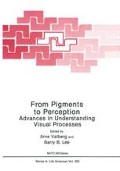Summary
A simple neural network is used to decode spatial pattern information in measured temporal firing patterns of a cell in the primary visual cortex of a macaque monkey. In this way one can quantify how much information beyond that contained in the average spike count is coded in the temporal modulation of the cell’s activity. Most of the results obtained here are for simple discriminations between spike trains generated by two Walsh-pattern stimuli; some are for a task of identifying the correct one out of 4 such stimuli. A simple information-theoretic analysis of the trained networks indicates that significant extra information, of the order of 50% of that contained in the spike count, is carried in the temporal modulation.
Access this chapter
Tax calculation will be finalised at checkout
Purchases are for personal use only
Preview
Unable to display preview. Download preview PDF.
References
Abramson, N., 1963, “Information Theory and Coding,” New York, McGraw-Hill.
Bailey, J. and Hammarstrom, D., 1988, Why VLSI implementation of associative VLCNs requires connection multiplexing, Proc. IEEE Conf. on Neural Networks II:173–180, San Diego.
Bialek, W., Rieke, F., de Ruyter, R. R., van Steveninck and Warland, D., 1990, Reading a Neural Code,in “Advances in Neural Information Processing Systems” 2, D. S. Touretzky, ed., San Mateo CA, Morgan Kaufmann.
Cybenko, G., 1989, Approximation by superpositions of a sigmoidal function. Math. of Controls, Signals, and Systems 2: 303–314.
Gawne, T. J., McClurkin, J. W., Richmond B. J. and Optican, L.M., 1990, Lateral geniculate neurons in behaving monkeys: III. Predictive power of a multi-channel model. Submitted to J. Neurophysiol.
McClurkin, J. W., Gawne, T. J., Richmond, B. J., Optican, L. M. and Robinson D. L., 1990, Lateral geniculate neurons in behaving monkeys: I. Responses to two-dimensional stimuli. Submitted to J. Neurophysiol.
McClurkin, J. W., Gawne, T. J., Richmond, B. J. and Optican, L. M., 1990, Lateral geniculate neurons in behaving monkeys: II. Encoding of visual information in the temporal modulation of the spike train. Submitted to J. Neurophysiol.
Minsky, M. and Papert, S., 1969, “Perceptrons,” Cambridge MA, MIT Press.
Optican, L. M. and Richmond, B. J., 1987, Temporal encoding of two-dimensional patterns by single units in primate inferior temporal cortex. III. Information theoretic analysis. J. Neurophysiol., 57: 162–178.
Richmond, B.J. and Optican, L. M., 1987, Temporal encoding of two-dimensional patterns by single units in primate inferior temporal cortex. II. Quantification of response waveform. J. Neurophysiol., 57: 147–161.
Richmond, B.J. and Optican, L. M. 1990, Temporal encoding of two-dimensional patterns by single units in primate primary visual cortex: II. Information transmission. J. Neurophysiol., 64: 370–380.
Richmond, B. J., Optican, L. M. and Gawne, T.J., 1989, Neurons use multiple messages encoded in temporally modulated spike trains to represent pictures. in “Seeing Contour and Colour”, J. J. Kulikowski and C. M. Dickinson, eds., Oxford, Pergamon Press.
Richmond, B.J., Optican, L. M., Podell, M. and Spitzer, H., 1987, Temporal encoding of two-dimensional patterns by single units in primate inferior temporal cortex. I. Response characteristics. J. Neurophysiol., 57: 132–146.
Richmond, B. J., Optican, L. M. and Spitzer, H., 1990, Temporal encoding of two-dimensional patterns by single units in primate primary visual cortex: I. Stimulus-response relations. J. Neurophysiol., 64: 351–369.
Rumelhart, D. E., Hinton, G. E. and Williams, R. J., 1986, Learning internal representations by back-propagating errors. Nature, 323: 533–536.
de Ruyter, R. R., van Steveninck S. and Bialek, W., 1988, Real-time performance of a movement-sensitive neuron in the blowfly visual system: coding and information transfer in short spike sequences. Proc. Roy. Soc. B, 234: 379–414.
Author information
Authors and Affiliations
Editor information
Editors and Affiliations
Rights and permissions
Copyright information
© 1991 Springer Science+Business Media New York
About this chapter
Cite this chapter
Hertz, J.A., Richmond, B.J., Hertz, B.G., Optican, L.M. (1991). Neural Decoding. In: Valberg, A., Lee, B.B. (eds) From Pigments to Perception. NATO ASI Series, vol 203. Springer, Boston, MA. https://doi.org/10.1007/978-1-4615-3718-2_49
Download citation
DOI: https://doi.org/10.1007/978-1-4615-3718-2_49
Publisher Name: Springer, Boston, MA
Print ISBN: 978-1-4613-6654-6
Online ISBN: 978-1-4615-3718-2
eBook Packages: Springer Book Archive

